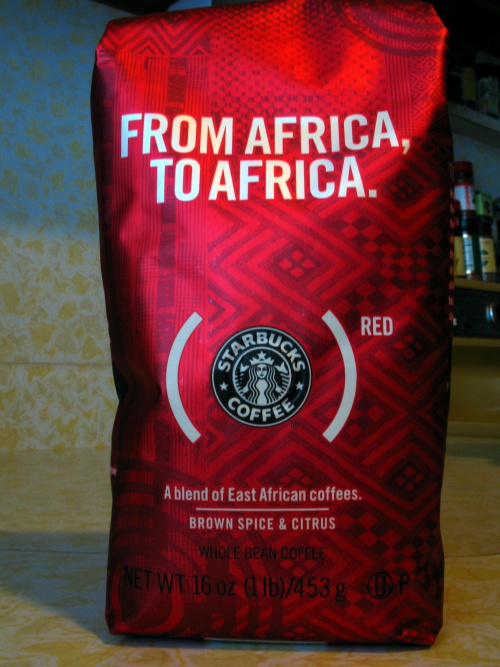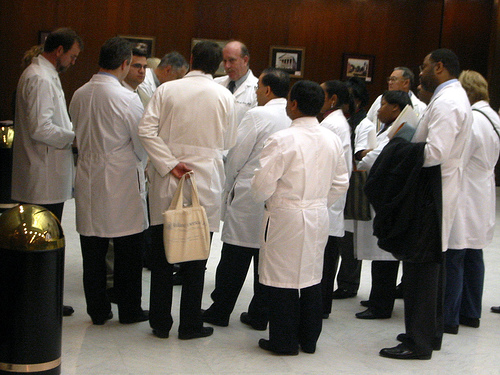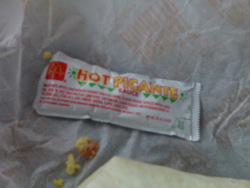 photo by youcansleepwhenyouredead
photo by youcansleepwhenyouredead
I've been reading Michael Pollan's In Defense of Food: An Eater's Manifesto and to say the book is excelent would be to describe the Golden Gate Bridge "nice." It is a true manifesto and a call to action. Although much of the research he details in the book is still in progress - and often controvercial, it opens your eyes to contemporary theories in nutritionism.
and to say the book is excelent would be to describe the Golden Gate Bridge "nice." It is a true manifesto and a call to action. Although much of the research he details in the book is still in progress - and often controvercial, it opens your eyes to contemporary theories in nutritionism.
Some of these theories revolve around omega-3 and omega-6 fatty acids; both of which are unsaturated. What has been known for a long time in the scientific comminity is just beginning to gain press, that "not all fats are created equal." The American Heart Association even has a page on their website for children called Meet the Fats, going into the differences between Trans, Saturated, Poly- and Mono- unsaturated.
The media have made popular the evidence that omega-3's may have a link to possibly limit the risk of heart disease. People have been supplementing omega-3's in their diet (usually in the form of fish oil) for many years and more recently, it seems that flax seed is getting put into practically everything.
What Pollan and much of the researchers he cites are starting to divulge is the idea that omega-3 suppliments alone may not account for improved cardiovascular health. There is evidence to suggest that what is more important than an increase in omega-3 is a proper ratio of omega-6 to omega-3 (called n-6 and n-3 for short). This ideal ratio of n-6 to n-3 is hypothesized to be between 1:1 and 4:1.
What makes this difficult is that the typical American diet is overwhelmed with government subsidized corn and soy. The oils of which carry n-6 to n-3 ratios of 46:1 and 7:1 respectively. What's even more alarming Pollan states that, "Nine percent of the calories in the American diet today come from a single omega-6 fatty acid: linoleic acid, most of it from soybean oil" (In Defense of Food page 131)
That's a profound thought. Consider this, if true, of all the compounds humans can consume, digest, and extract energy from... 9% of the energy in the typical American diet comes from this single molecule. We are omnivorous and benefit from a varied diet.
 Linoleic acid
Linoleic acid
According to the Omega-3 wiki, "Typical Western diets provide ratios of between 10:1 and 30:1" and they list the ratios of n-6 to n-3 of some common cooking oils:
- Corn 46:1
- Soybean 7:1
- Olive between 3:1 and 13:1
- Canola 2:1
- Sunflower (no n−3)
- Grapeseed (almost no n−3)
- Cottonseed (almost no n−3)
- Peanut (no n−3)
- Flax 1:3
They continue:
It should be noted that olive, peanut and canola oils consist of approximately 80% monounsaturated fatty acids, (i.e. neither n−6 nor n−3) meaning that they contain relatively small amounts of n−3 and n−6 fatty acids. Consequently, the n−6 to n−3 ratios for these oils (i.e. olive, canola and peanut oils) are not as significant as they are for corn, soybean and sunflower oils.
What compounds our consumption of omega-6's is that livestock and poultry feed in this country is largely made up of corn and soy as well. A project completed at Cal State Chico showed that grain-fed beef had a ratio of 4:1 (n-6 to n-3) vs. grass fed beef which was about 2:1. Ergo, there are even more n-6's making their way into our diets than one might be natural because they are coming from not only plant but animal sources.
This shift in our entire ecosystem from one based on leaves to one that is based on seeds (corn, soy, olive, peanut, etc.) is pivotal in Pollan's manifest. It tipped the ratios of fatty acids far towards the omega-6 side, but he also states it, "helps account for the flood of refined carbohydrates in the modern diet and the draught of so many micronutrients and the surfeit of total calories."
Joseph Hibbeln, a prominent researcher at the National Institute of Health, has done extensive research on how these compounds effect our health - and specifically our mental health. He believes that much of our society's reliance on anti-inflammatory drugs such as aspirin, ibuprofen, and acetaminophen are to quell the effects of too much omega-6 fatty acids in our diet.
In April 2006, Hibbeln (et al) published an article called Omega-3 fatty acid deficiencies in neurodevelopment, aggression and autonomic dysregulation: Opportunities for intervention - concluding the Summary with, "Ensuring optimal intakes of omega-3 fatty acids during early development and adulthood shows considerable promise in preventing aggression and hostility."
In December 2006, Hibbeln (et al) published another article called Omega-3 fatty acids: evidence basis for treatment and future research in psychiatry. They suggest, "EPA and DHA [two specific omega-3 fatty acids] appear to have negligible risks and some potential benefit in major depressive disorder and bipolar disorder..."
From In Defense of Food, Pollan quotes Hibbeln:
"The increases in world [omega-6] consumption over the past century may be considered a very large uncontrolled experiment that may have contributed to increased societal burdens of aggression, depression, and cardiovascular mortality."
...I feel like eating a bowl of oatmeal now.
















